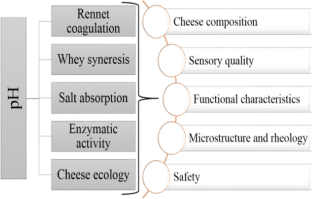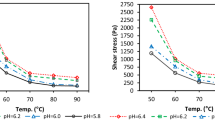Abstract
Cheese production has emerged as science and technology in the past few years, which was considered an artisan craft in the earlier period. However, despite intensive research work from many decades, the complex changes that occur during preparation and ripening of cheese are not apparent, affecting the quality and safety of cheese. Over time, several factors are studied and reviewed that affect cheese quality. The pH of the cheese curd matrix from manufacturing till ripening is one of the most crucial parameters that governs several aspects of cheese quality. Therefore, this paper aims to highlight the effect of pH on various processes (such as rennet coagulation, whey syneresis, salt absorption and ripening), microstructure and dynamic rheology, and microbiological changes that regulate the overall quality and safety aspects of cheeses. Understanding the role of pH on cheese quality parameters will aid to make better and more consistent cheeses that will satisfy both the consumers and cheese-makers.


Similar content being viewed by others
Availability of data and material (data transparency)
Not applicable.
Code availability (software application or custom code)
Not applicable.
Abbreviations
- CCP:
-
Colloidal calcium phosphate
- CN:
-
Casein
- CEP:
-
Cell envelop protease
- CLP:
-
Calcium lactate pentahydrate
- FPC:
-
Fermentation produced chymosin
- LAB:
-
Lactic acid bacteria
- MT:
-
Million tonnes
- NSLAB:
-
Non-starter lactic acid bacteria
- RCT:
-
Rennet coagulation time
- SLAB:
-
Starter lactic acid bacteria
References
Ardö Y, McSweeney PLH, Magboul AA, Upadhyay VK, Fox PF (2017) Biochemistry of cheese ripening: proteolysis. In: McSweeney PLH, Fox PF, Cotter, PD, Everett DW (eds) Cheese-chemistry, physics and microbiology: general aspects, 4th edn. Academic press, London, UK, pp 445–482. doi: https://doi.org/10.1016/B978-0-12-417012-4.00018-1
Bansal V, Mishra SK (2020) Reduced-sodium cheeses: implications of reducing sodium chloride on cheese quality and safety. Compr Rev Food Sci Food Saf 19:733–758. https://doi.org/10.1111/1541-4337.12524
Batty D, Waite-Cusic JG, Meunier-Goddik L (2019) Influence of cheese-making recipes on the composition and characteristics of Camembert-type cheese. J Dairy Sci 102:164–176. https://doi.org/10.3168/jds.2018-14964
Brown LW, Price WV (1934) A study of the relationship between hydrogen ion concentration, titratable acidity, and quality of Cheddar cheese. J Dairy Sci 17:33–45
Cantor MD, van den Tempel T, Hansen TK, Ardö Y (2017) Blue cheese. In: McSweeney PLH, Fox PF, Cotter PD, Everett DW (eds), Cheese: chemistry, physics and microbiology, 4th edn, vol. 2. Elsevier Ltd., London, UK, pp. 929–954. https://doi.org/10.1016/B978-0-12-417012-4.00037-5
Centers for Disease Control and Prevention (2013) Vital signs: Listeria illnesses, deaths, and outbreaks—United States, 2009–2011. MMWR 62:448–452. https://www.cdc.gov/mmwr/pdf/wk/mm6222.pdf
Choi J, Horne DS, Lucey JA (2007) Effect of insoluble calcium concentration on rennet coagulation properties of milk. J Dairy Sci 90:2612–2623. https://doi.org/10.3168/jds.2006-814
Choi KH, Lee H, Lee S, Kim S, Yoon Y (2016) Cheese microbial risk assessments: a review. Asian-Australas J Anim Sci 29:307–314. https://doi.org/10.5713/ajas.15.0332
D’Amico DJ, Druart MJ, Donnelly CW (2008) 60-Day aging requirement does not ensure safety of surface-mold-ripened soft cheeses manufactured from raw or pasteurized milk when Listeria monocytogenes is introduced as a postprocessing contaminant. J Food Prot 71:1563–1571. https://doi.org/10.4315/0362-028x-71.8.1563
Dairy Industries International (2020) Global cheese markets hit record highs. Bell Publishing Ltd, United Kingdom. https://www.dairyindustries.com/news/35273/global-cheese-markets-hit-record-highs/. Accessed 6 July 2021
Dalgleish DG, Corredig M (2012) The structure of the casein micelle of milk and its changes during processing. Annu Rev Food Sci Technol 3:449–467. https://doi.org/10.1146/annurev-food-022811-101214
Falardeau J, Trmčić A, Wang S (2021) The occurrence, growth, and biocontrol of Listeria monocytogenes in fresh and surface-ripened soft and semisoft cheeses. Compr Rev Food Sci Food Saf 20:4019–4048. https://doi.org/10.1111/1541-4337.12768
Fox PF (2011) Cheese: overview. In: Fuquay JW, Fox PF, McSweeney PLH (eds) Encyclopedia of dairy sciences, 2nd edn. Elsevier Science Publishing Co Inc., San Diego, pp 524–543
Fox PF, Cogan TM, Guinee TP (2017a) Factors that affect the quality of cheese. In: McSweeney PLH, Fox PF, Cotter PD, Everett DW (eds) Cheese: chemistry, physics and microbiology, 4th edn. Academic Press, London, pp 617–641. https://doi.org/10.1016/B978-0-12-417012-4.00025-9
Fox PF, Guinee TP, Cogan TM, McSweeney PLH (2017b) Fundamentals of cheese science. Springer, Boston. https://doi.org/10.1007/978-1-4899-7681-9_9
Fox PF, Guinee TP, Cogan TM, McSweeney PLH (2017c) Salting of cheese curd. In: Fundamentals of cheese science. Springer, Boston, pp 251–277. https://doi.org/10.1007/978-1-4899-7681-9_9
Fox PF, McSweeney PLH (2017) Cheese: an Overview. In: McSweeney PLH, Fox PF, Cotter PD, Everett DW (eds) Cheese—chemistry, physics and microbiology: general aspects, 4th edn. Academic Press, London, pp 1–21. doi: https://doi.org/10.1016/S1874-558X(04)80060-5
Giroux HJ, Lemaire N, Britten M (2022) Effect of cheese composition and cheese-making conditions on salt and moisture transfer during brining. Int Dairy J. https://doi.org/10.1016/j.idairyj.2022.105325
Gobbetti M, Cagno RD (2017) Extra-hard varieties. In: McSweeney PLH, Fox PF, Cotter PD, Everett DW (eds) Cheese: chemistry, physics and microbiology, 4th edn. Academic Press, London, pp 809–828. https://doi.org/10.1016/B978-0-12-417012-4.00032-6
Gobbetti M, Cagno RD (2022) Extra-hard varieties. In: McSweeney PLH, McNamara JP (eds) Encyclopedia of dairy sciences, 3rd edn. Elsevier, Amsterdam, pp 172–195
Gobbetti M, Lanciotti R, De Angelis M, Corbo MR, Massini R, Fox PF (1999) Study of the effect of temperature, pH and NaCl on the peptidase activities of non-starter lactic acid bacteria (NSLAB) by quadratic response surface methodology. Int Dairy J 9:865–875. https://doi.org/10.1016/S0958-6946(99)00156-9
Gould LH, Mungai E, Barton Behravesh C (2014) Outbreaks attributed to cheese: differences between outbreaks caused by unpasteurized and pasteurized dairy products, United States, 1998–2011. Foodborne Pathog Dis 11:545–551. https://doi.org/10.1089/fpd.2013.1650
Guinee TP (2022) Cheese rheology and texture. In: McSweeney PLH, McNamara JP (eds) Encylopedia of dairy sciences, vol III, 3rd edn. Elsevier, Amsterdam, pp 112–129
Guinee TP, Sutherland BJ (2022) Salting of cheese. In: McSweeney PLH, McNamara JP (eds) Encylopedia of dairy sciences, vol III, 3rd edn. Elsevier, Amsterdam, pp 321–335
Harboe M, Broe ML, Qvist KB (2010) The production, action and application of rennet and coagulants. In: Law BA, Tamime AY (eds) Technology of cheese making, 2nd edn. Wiley, Oxford, pp 98–129. https://doi.org/10.1002/9781444323740
Janhøj T, Qvist KB (2010) The formation of cheese curd. In: Law BA, Tamime AY (eds) Technology of cheese making, 2nd edn. Wiley, Oxford, pp 130–165. https://doi.org/10.1002/9781444323740
Johnson A, Sommer D (2020) Essential principles of cheese making (part 2): measuring and controlling acidity and moisture. Dairy Pipeline 31:1–12
Johnson M, Law BA (2010) The origins, development and basic operations of cheesemaking technology. In: Law BA, Tamime AY (eds), Technology of cheese making, 2nd edn. Wiley, Oxford, pp 68–97. https://doi.org/10.1002/9781444323740
Johnson ME (2017) A 100-year review: cheese production and quality. J Dairy Sci 100:9952–9965. https://doi.org/10.3168/jds.2017-12979
Kapetanakou AE, Gkerekou MA, Vitzilaiou ES, Skandamis PN (2017) Assessing the capacity of growth, survival, and acid adaptive response of Listeria monocytogenes during storage of various cheeses and subsequent simulated gastric digestion. Int J Food Microbiol 246:50–63. https://doi.org/10.1016/j.ijfoodmicro.2017.01.015
Kilcawley K, O’Sullivan M (2018) Cheese flavor development and sensory characteristics. In: Papademas P, Bintsis T (eds) Global cheese making technology: cheese quality and characteristics. Wiley, Hoboken, pp 45–70. https://doi.org/10.1002/9781119046165.ch0c
Kongo JM (2013) Lactic acid bacteria as starter-cultures for cheese processing: past, present and future developments. In: Kongo JM (ed) Lactic acid bacteria: R & D for food, health and livestock purposes. Intechopen, London, pp 1–20. https://doi.org/10.5772/55937
Larsson M, Zakora M, Dejmek P, Ardö Y (2006) Primary proteolysis studied in a cast cheese made from microfiltered milk. Int Dairy J 16:623–632. https://doi.org/10.1016/j.idairyj.2005.08.012
Leong WM, Geier R, Engstrom S, Ingham S, Ingham B, Smukowski M (2014) Growth of Listeria monocytogenes, Salmonella spp., Escherichia coli O157: H7, and Staphylococcus aureus on cheese during extended storage at 25°C. J Food Prot 77:1275–1288. https://doi.org/10.4315/0362-028X.JFP-14-047
Lucey JA (2022) Rennet coagulation of milk. In: McSweeney PLH, McNamara JP (eds) Encyclopedia of dairy sciences, 3rd edn. Elsevier, Amsterdam, pp 309–315
Monteiro RR, Tavares DQ, Kindstedt PS, Gigante ML (2009) Effect of pH on microstructure and characteristics of cream cheese. J Food Sci 74:C112–C117. https://doi.org/10.1111/j.1750-3841.2008.01037.x
Murtaza MA, Ur-Rehman S, Anjum FM, Huma N, Hafiz I (2014) Cheddar cheese ripening and flavor characterization: a review. Crit Rev Food Sci Nutr 54:1309–1321. https://doi.org/10.1080/10408398.2011.634531
Nega A, Moatsou G (2012) Proteolysis and related enzymatic activities in ten Greek cheese varieties. Dairy Sci Technol 92:57–73. https://doi.org/10.1007/s13594-011-0043-4
Ong L, Pax AP, Ong A, Vongsvivut J, Tobin MJ, Kentish SE, Gras SL (2020) The effect of pH on the fat and protein within cream cheese and their influence on textural and rheological properties. Food Chem 332:127327. https://doi.org/10.1016/j.foodchem.2020.127327
Picon A (2018) Cheese microbial ecology and safety. In: Papademas P, Bintsis T (eds) Global cheese making technology: cheese quality and characteristics. Wiley, Hoboken, pp 71–99. https://doi.org/10.1002/9781119046165.ch0d
Piras C, Marincola FC, Savorani F, Engelsen SB, Cosentino S, Viale S, Pisano MB (2013) A NMR metabolomics study of the ripening process of the Fiore Sardo cheese produced with autochthonous adjunct cultures. Food Chem 141:2137–2147. https://doi.org/10.1016/j.foodchem.2013.04.108
Radovanovic M, Hovjecki M, Radulovic A, Rac V, Miocinovic J, Jovanovic R, Pudja P (2021) Rheology of buffalo milk rennet coagulation and gels affected by coagulation temperature, CaCl2, pH and milk heat treatment. Int Dairy J 121:105122. https://doi.org/10.1016/j.idairyj.2021.105122
Sandra S, Cooper C, Alexander M, Corredig M (2011) Coagulation properties of ultrafiltered milk retentates measured using rheology and diffusing wave spectroscopy. Food Res Int 44:951–956. https://doi.org/10.1016/j.foodres.2011.02.018
Schoder D, Skandamis P, Wagner M (2013) Assessing in-house monitoring efficiency by tracing contamination rates in cheese lots recalled during an outbreak of listeriosis in Austria. Int J Food Microbiol 167:353–358. https://doi.org/10.1016/j.ijfoodmicro.2013.09.020
Swearingen PA, Adams DE, Lensmire TL (2004) Factors affecting calcium lactate and liquid expulsion defects in Cheddar cheese. J Dairy Sci 87:574–582. https://doi.org/10.3168/jds.S0022-0302(04)73199-9
Trmčić A, Ralyea R, Meunier-Goddik L, Donnelly C, Glass K, D’Amico D, Meredith E, Kehler M, Tranchina N, McCue C, Wiedmann M (2017) Consensus categorization of cheese based on water activity and pH: a rational approach to systemizing cheese diversity. J Dairy Sci 100:841–847. https://doi.org/10.3168/jds.2016-11621
Vélez MA, Perotti MC, Candioti MC, Bergamini CV, Hynes ER (2016) Plasmin and coagulant activities in a minicurd model system: Study of technological parameters. J Dairy Sci 99:7053–7062. https://doi.org/10.3168/jds.2015-10799
Vliet TV, Walstra P (1994) Water in casein gels; how to get it out or keep it in. J Food Eng 22:75–88. https://doi.org/10.1016/0260-8774(94)90026-4
Voigt DD, Patterson MF, Linton M, Kelly AL (2011) Effect of high-pressure treatment of milk prior to manufacture on ripening of Camembert cheese. Innov Food Sci Emerg Technol 12:1–5. https://doi.org/10.1016/j.ifset.2010.12.001
Wolfschoon-Pombo AF, Andlinger DJ (2013) Micellar calcium in acid curd cheese with different pH values, fat and protein levels. Int Dairy J 32:20–25. https://doi.org/10.1016/j.idairyj.2013.03.011
Yang Y, Shevchenko A, Knaust A, Abuduresule I, Li W, Hu X, Wang C, Shevchenko A (2014) Proteomics evidence for kefir dairy in Early Bronze Age China. J Archaeol Sci 45:178–186. https://doi.org/10.1016/j.jas.2014.02.005
Acknowledgements
Authors are thankful to the Dean and Head of the Dairy Technology and Dairy Chemistry Department, College of Dairy Science and Technology, GADVASU, Ludhiana for their support in providing all necessary facilities.
Funding
This research did not receive any specific grant from funding agencies in the public, commercial, or not-for-profit sectors.
Author information
Authors and Affiliations
Contributions
VB wrote the manuscript. NV edited the manuscript.
Corresponding author
Ethics declarations
Ethics approval
Not applicable.
Competing interests
The authors declare that they have no competing interests.
Consent to participate (include appropriate consent statements)
Not applicable.
Consent for publication
Not applicable.
Additional information
Publisher's Note
Springer Nature remains neutral with regard to jurisdictional claims in published maps and institutional affiliations.
Rights and permissions
Springer Nature or its licensor (e.g. a society or other partner) holds exclusive rights to this article under a publishing agreement with the author(s) or other rightsholder(s); author self-archiving of the accepted manuscript version of this article is solely governed by the terms of such publishing agreement and applicable law.
About this article
Cite this article
Bansal, V., Veena, N. Understanding the role of pH in cheese manufacturing: general aspects of cheese quality and safety. J Food Sci Technol 61, 16–26 (2024). https://doi.org/10.1007/s13197-022-05631-w
Revised:
Accepted:
Published:
Issue Date:
DOI: https://doi.org/10.1007/s13197-022-05631-w




